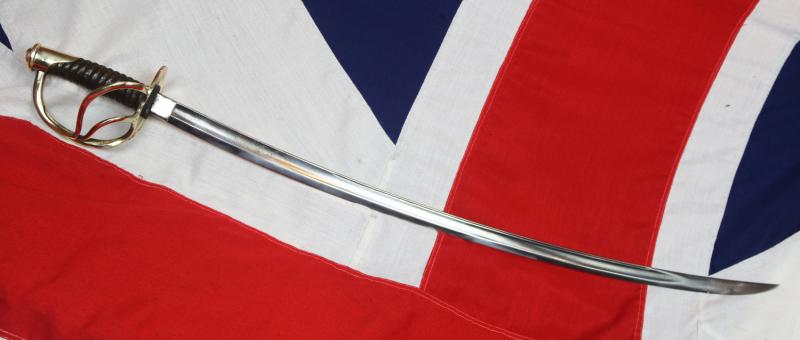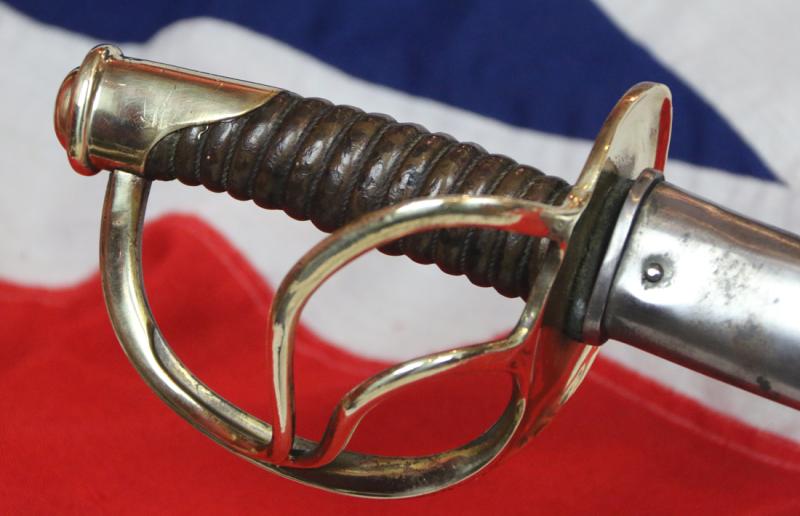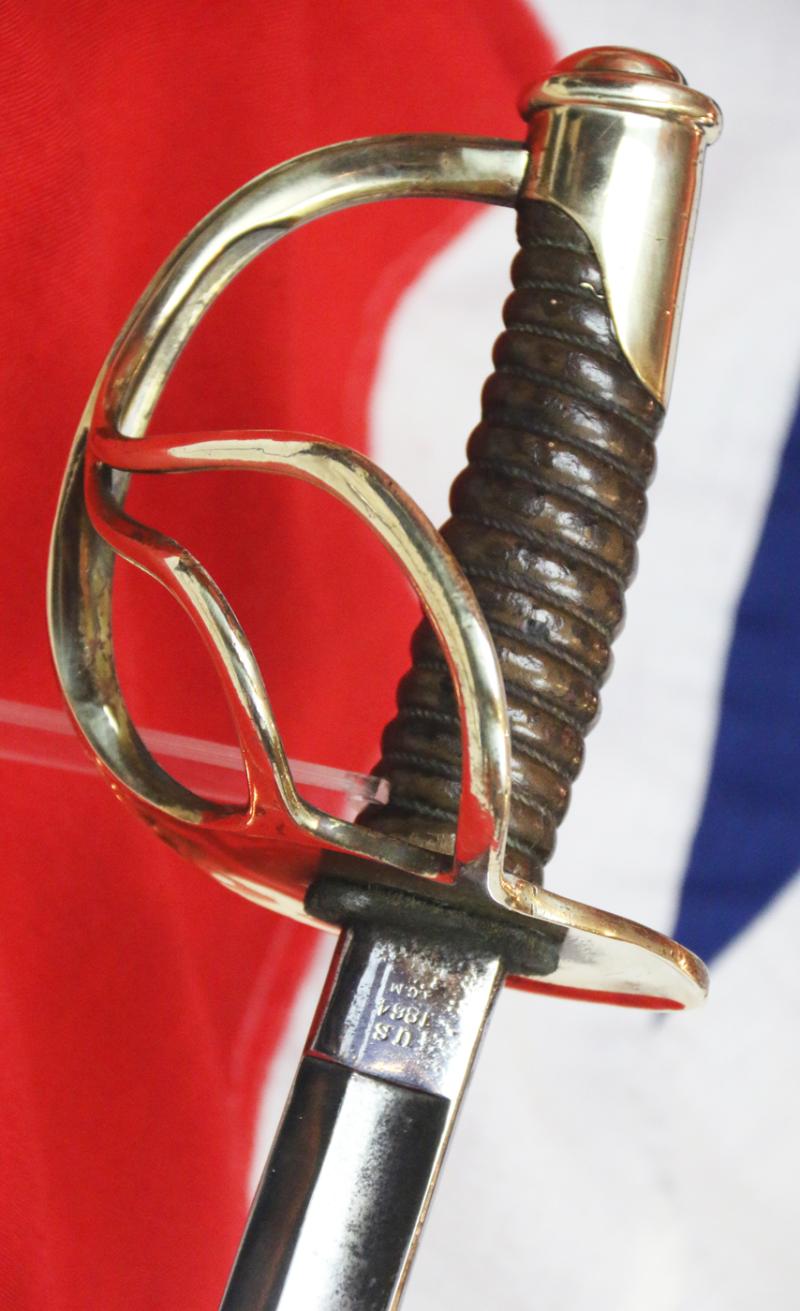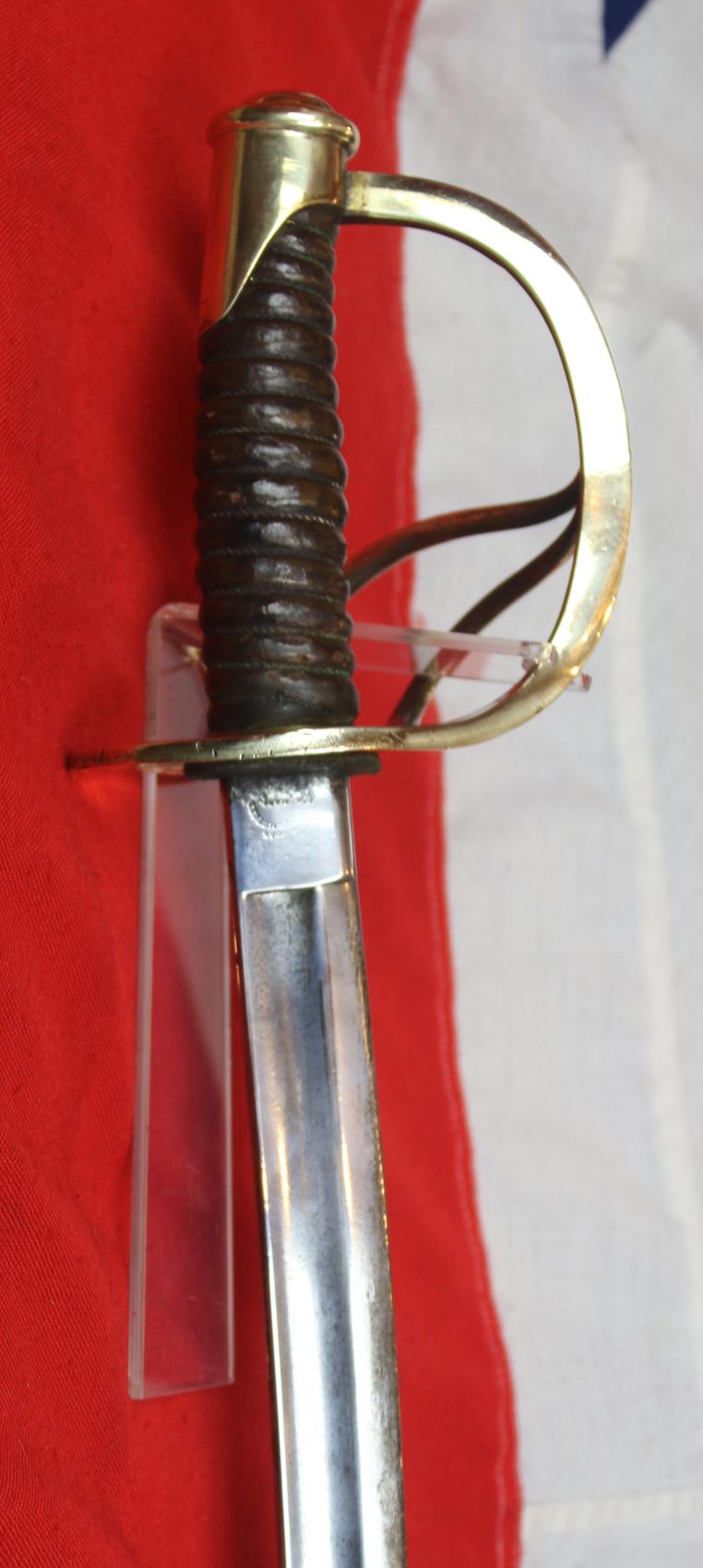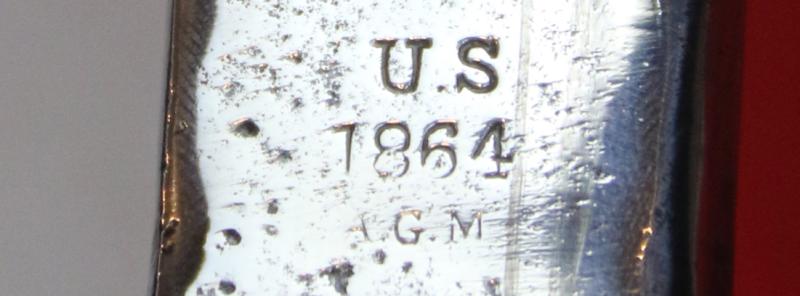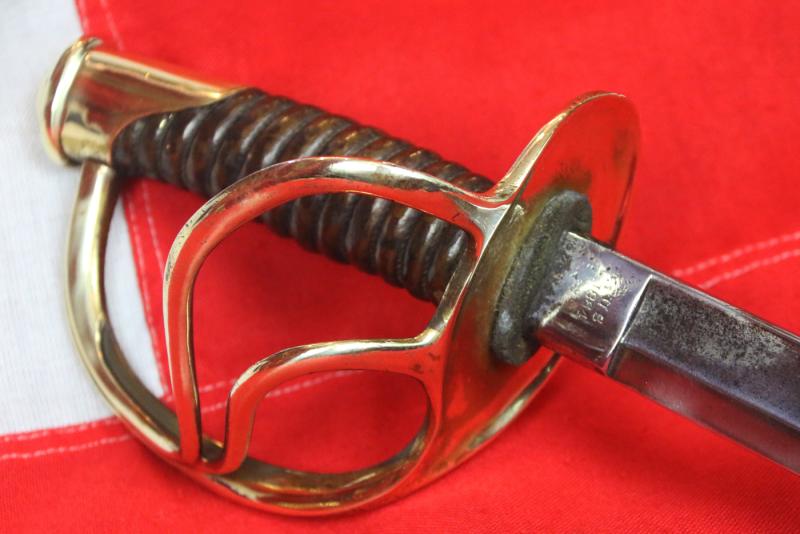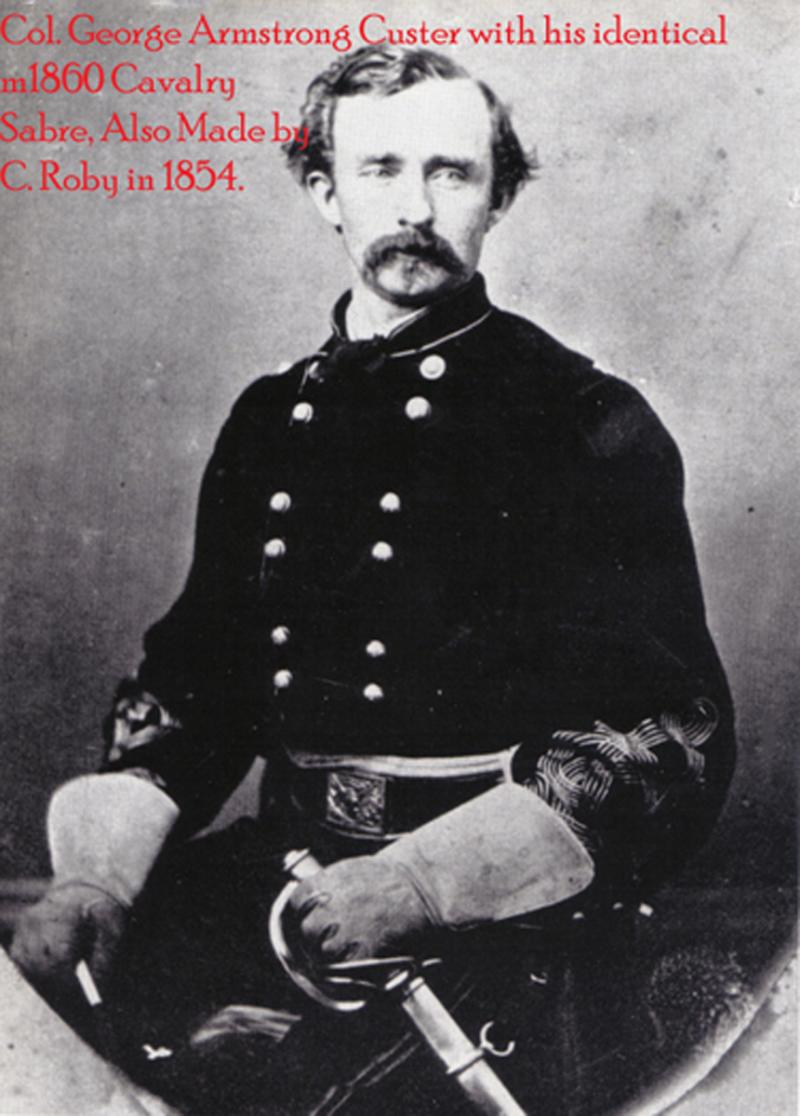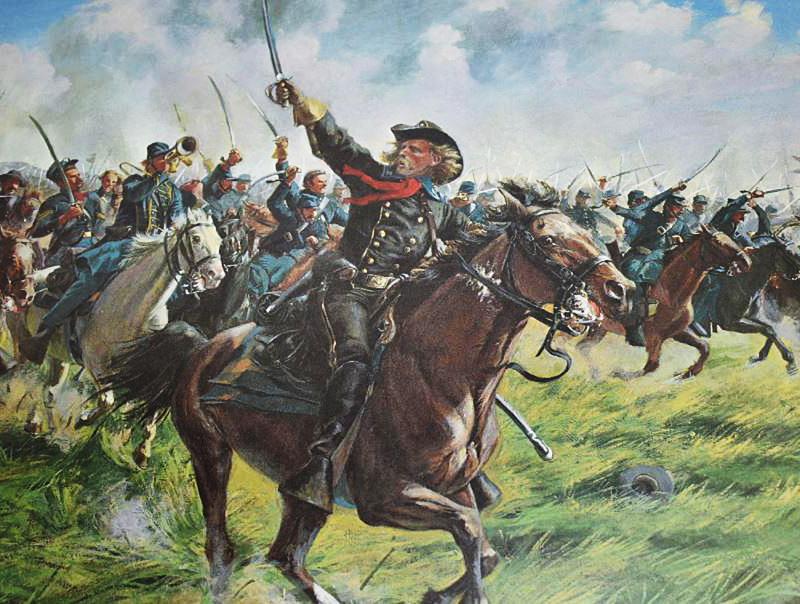Superb US Civil War Cavalry Sabre By Roby, Chelmsford Mass. Dated 1864 Identical to General George Armstrong Custer's Cavalry Sabre, An 1864 Roby Contract, Inspected by AGM For Custer's Wolverines Sabres. Possibly Made For The Michigan Brigade Contract
The Model 1860 Light Cavalry Sabre. Traditional three bar brass hilt, cushion pommel and ribbed wooden grip. Made by the same maker in the same year and even inspected by the very same man A.G.Manning as Custer's and his Wolverine's sabres. Made by C.Roby of Chelmsford Mass. Civil War Union Government inspectors initials stamped at blade forte 'A.G.M'. One of the US Army sword inspectors, Alfred G. Munnings. This is the very same sword pattern, year, and maker, as was used by Col.George Armstrong Custer, that was also inspected by Alfred Munnings.
Custer's sword was late of the Charles A.Custer's family collection, and it's maker, date and inspector's initial stamp AGM are well documented. Custer is shown wearing his sabre in a photo in the gallery for information only not included with sword. This sabre was obviously made, and part of, the same Union cavalry contract as the swords supplied to Col. Custer, and 'Custer's Wolverines, the Michigan Brigade'. This sword is a Union contract purchased sword, with the sword's blade maker marked by C.Roby of Chelmsford, Mass. American government contract inspector stamped, AGM Alfred G. Manning, and dated 1864. The Michigan Brigade, sometimes called the Wolverines, the Michigan Cavalry Brigade or Custer's Brigade, was a brigade of cavalry in the volunteer Union Army during the latter half of the American Civil War. Composed primarily of the 1st Michigan Cavalry, 5th Michigan Cavalry, 6th Michigan Cavalry and 7th Michigan Cavalry, the Michigan Brigade fought in every major campaign of the Army of the Potomac from the Battle of Gettysburg in July 1863 to the Confederate surrender at Appomattox Court House in April 1865.
The brigade first gained fame during the Gettysburg Campaign under the command of youthful Brigadier General George Armstrong Custer. After the war, several men associated with the brigade joined the 7th U.S. Cavalry Regiment and later fought again under Custer in the Old West frontier.
In the first half of the war, the Confederates enjoyed the advantage in cavalry, as southern men were more accustomed to the riding and shooting life, and most of the experienced cavalry officers from the regular army had chosen to side with the Confederacy . A notable example was Bedford Forrest, who effectively dominated Tennessee & northern Mississippi until the end of the war.
By the second half, from 1863 onward, the Union Army had gained an equal cavalry capability, through Benjamin Grierson’s brilliant deception tactics in the Mississippi valley, and Philip Sheridan’s aggressive movements, while in command of the Army of the Shenandoah at the end of the war in Virginia.
Cavalry units proved highly expensive to maintain, and unscrupulous agents would often exploit shortages by supplying defective animals at exorbitant prices. Offensive actions were certainly not unknown, however, but they were more frequently employed against enemy cavalry than against infantry. Examples of offensive actions include the Battle of Brandy Station and the Battle of Yellow Tavern; cavalry versus cavalry examples include the First Battle of Bull Run and Elon J. Farnsworth's ill-fated charge on the third day of the Battle of Gettysburg.
Reconnaissance was the key to effective cavalry, as it remains today in modern armies (although modern cavalrymen use light armored vehicles or helicopters instead of horses). The cavalry serves as the "eyes" of the army. Reconnaissance was a crucial component in the Gettysburg Campaign, where cavalry under Union General Alfred Pleasonton attempted to find the wide-ranging Army of Northern Virginia on its invasion of the North, and Confederate cavalry under J.E.B. Stuart effectively employed counter-reconnaissance to screen passes in the Blue Ridge Mountains and hide Robert E. Lee's movements.
Long-distance raids were the most desirable mission for cavalrymen, primarily because of the fame that successful raids would bring, but they were often of little practical strategic value. Jeb Stuart became famous for two audacious raids on the Union Army of the Potomac in 1862; in his third such attempt, during the Gettysburg Campaign, he squandered much of the cavalry forces of the Army of Northern Virginia and deprived Robert E. Lee of adequate reconnaissance at the beginning of the Battle of Gettysburg, one of the principal reasons for the Confederate defeat there. Union attempts at strategic raids had mixed success. George Stoneman's raid in the Battle of Chancellorsville was a failure; Benjamin Grierson's raid in the Vicksburg Campaign was a strategic masterpiece that diverted critical Confederate forces away from Ulysses S. Grant's army; James H. Wilson's massive 1865 raid in Alabama foreshadowed the armored warfare maneuvers of World War II. In general, strategic raids were used more effectively in the Western Theater of the war.
Defensive actions by the cavalry were critical in the retreat from Gettysburg. Pursuit and harassment of enemy forces were often neglected (particularly by the Union after Gettysburg and Antietam), but can be seen in their finest form in the pursuit of Robert E. Lee during the Appomattox Campaign. It has a later replaced scabbard, it likely lost its original scabbard in combat during the Civil War. this sword has just returned from days of hand conservation and hand polishing in our workshop.
Code: 24938


